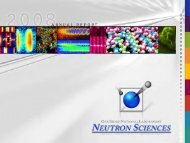Powder Diffraction - Spallation Neutron Source
Powder Diffraction - Spallation Neutron Source
Powder Diffraction - Spallation Neutron Source
You also want an ePaper? Increase the reach of your titles
YUMPU automatically turns print PDFs into web optimized ePapers that Google loves.
Reciprocal Lattice<br />
To simplify math when working with non-orthogonal coordinate systems,<br />
we use a construct called the reciprocal lattice (indicated by star)<br />
where each reciprocal axis is perpendicular to two “real space” axes:<br />
– a* • a = 1; a* • b = 0; a* • c = 0<br />
– b* • a = 0; b* • b = 1; b* • c = 0<br />
– c* • a = 0; c* • b = 0; c* • c = 1<br />
This means that if we have two vectors:<br />
r = xa + yb + zc and d* = ha* + kb* + lc*<br />
Then no cross-terms are needed for the dot product:<br />
r • d* = hx + ky + lz<br />
Use of the reciprocal lattice makes computation of the Fourier transform of<br />
the atomic positions straightforward.<br />
Historical note: the value of the reciprocal lattice for working with non-orthogonal<br />
coordinate systems was first recognized by J. Willard Gibbs (1881)<br />
66
















